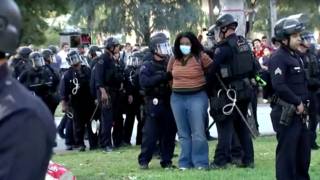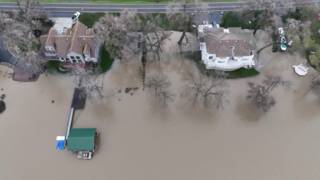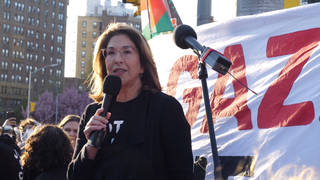
Related
Topics
Guests
- Mark Hertsgaardenvironmental reporter. His latest story is “How Growers Gamed California’s Drought.” He is also the author of the book, Hot: Living Through the Next Fifty Years on Earth.
As California’s record drought continues, Gov. Jerry Brown has ordered residents and non-agricultural businesses to cut water use by 25 percent in the first mandatory statewide reduction in the state’s history. One group not facing restrictions under the new rules is big agriculture, which uses about 80 percent of California’s water. The group Food & Water Watch California has criticized Brown for not capping water usage by oil extraction industries and corporate farms, which grow water-intensive crops such as almonds and pistachios, most of which are exported out of state and overseas. Studies show the current drought, which has intensified over the past four years, is the worst California has seen in at least 120 years. Some suggest it is the region’s worst drought in more than a thousand years. This comes after California witnessed the warmest winter on record. We speak with environmental reporter Mark Hertsgaard, author of the book, “Hot: Living Through the Next Fifty Years on Earth.”
Transcript
NERMEEN SHAIKH: California Governor Jerry Brown ordered residents and non-agricultural businesses to cut water use by 25 percent in the first mandatory statewide reduction in the state’s history. Ninety-eight percent of California is now suffering from drought. Governor Brown issued the executive order at the mostly snow-bare Phillips Station in the Sierra Nevada mountains. The nearby Sierra-at-Tahoe ski resort closed for the season weeks ago due to lack of snow.
GOV. JERRY BROWN: One thing we know is we’re standing on dry grass, and we should be standing in five feet of snow. That’s the way it has been. We’re in an historic drought, and that demands unprecedented action. For that reason, I’m issuing an executive order mandating substantial water reduction across our state. As Californians, we have to pull together and save water in every way we can. This executive order, which I signed today, it’s long. It covers a number of different details. In fact, I’ve never seen one quite like it before. It’s going to save water by mandating real reductions in a number of areas. It’s going to affect golf courses, people’s lawns, universities, campuses, all sorts of institutions, the median with vegetation on our roads and highways. It affects all of that.
NERMEEN SHAIKH: One group not facing restrictions under the new rules is big agriculture, which uses about 80 percent of California’s water. The group Food & Water Watch California criticized Brown for not capping water usage by corporate farms that grow water-intensive crops such as almonds and pistachios, most of which are exported out of state and overseas. Adam Scow of Food & Water Watch California said, quote, “In the midst of a severe drought, the governor continues to allow corporate farms and oil interests to deplete and pollute our precious groundwater resources.” Studies show the current drought, which has intensified over the past four years, is the worst California has seen in at least 120 years. Some studies suggest it is the worst drought in the region in more than a thousand years.
AMY GOODMAN: While much of the eastern United States experienced record cold temperatures, California, as well as Utah, Arizona, Nevada and Washington each saw their hottest winter ever. In January and February, temperatures were 1 degree Fahrenheit hotter in California than last year, which ended as the hottest year on record by nearly 2 degrees. Deke Arndt of the National Climatic Data Center said, quote, “The 21st century for sure is being characterized by persistent, ubiquitous drought in the West. The projection is for that to continue,” he said.
We go now to San Francisco, where we’re joined by environmental reporter Mark Hertsgaard. His latest story, “How Growers Gamed California’s Drought.” He’s also the author of the book, Hot: Living Through the Next 50 Years on Earth.
Mark Hertsgaard, welcome back to Democracy Now! Can you talk about what the governor has mandated, who is included and who isn’t?
MARK HERTSGAARD: Sure. It’s good to be here. The new executive order by Governor Brown, issued yesterday, really focused mainly on the urban sector. As he mentioned in the clip you just showed us, it’s going to affect golf courses and median strips and a number of other uses in the urban areas, where he demands a 25 percent mandatory immediate cut in consumption. That means that the water agencies, the public agencies in control in those areas of water supply, have to deliver 25 percent cuts. What was striking about the order is that it did not require those same kinds of cuts from the agriculture sector, which in California is the big player in water. Agriculture uses about 80 percent of all the developed water here in the state.
I should add, Amy, that Governor Brown’s spokespersons, when I contacted them last night, said that it was true that the executive order only required, quote, “plans” from these big agricultural water districts, but they pointed out that the water districts have already been cut back earlier this year. Both the state supplies and the water system—sorry, the state and the federal water supplies have already been cut back by a larger amount. Nevertheless, the new executive order does focus mainly on the cities, not on the countryside.
NERMEEN SHAIKH: Mark, could you explain why it is—why is agriculture exempt from the orders that the governor has given?
MARK HERTSGAARD: From the new orders, it’s what the—again, what the spokespersons for the governor say is that, look, they’ve already—agriculture has already taken a hit. It’s been, they say, a bigger hit than we’re asking from urban users, and we plan to ask for more, going down the road. The plans that are required under Governor Brown’s executive order from the agricultural water districts will be used—the governor’s aides say they will be used to try to diminish the amount of groundwater that’s being consumed in the future.
And that’s a key thing for people to understand, that right now, when there is no rain—and we’re going in now to the fourth year of this historic drought here in California. And when there is no rain, and there’s not enough supply coming from the reservoirs and so forth, what happens is that the farmers basically drill deeper down under the earth to get the groundwater, the ancient groundwater that’s down there. And in a normal year in California, that groundwater provides about 40 percent of our water supply, but in the dry years, it’s up to 60 percent. If you go down to the Central Valley, where most of the farming takes place, as I have on reporting trips, you know, we’re now in a kind of an agricultural arms race down there, where farmers, neighboring farmers, everyone is trying to drill deeper and deeper wells to get down and grab that groundwater. And, of course, that does favor the larger corporate farmers over the smaller mom-and-pop operations.
The big danger of that, though—and this is the real, potential doomsday scenario here in California—is that the more that you go down and use that groundwater and suck it up like a straw, the greater danger is—the greater the danger is that you collapse those aquifers underground, that they compress, and you essentially have a situation where they are rendered barren in perpetuity. And that would be a real problem. So, we can’t keep relying on this groundwater depletion forever. There has to be a smarter way to do this.
AMY GOODMAN: When California Governor Jerry Brown announced his water restrictions Wednesday, he was joined by Frank Gehrke, the California’s Department of Water Resources. He said the state’s snowpack, a major source of water for the rest of the year, is at its lowest level on record.
FRANK GEHRKE: You’re at the Phillips snow course for the April 1st, 2015, measurement, and as you can clearly see, there is no snow at this location. And this is the first year in its measurements, going back to 1942, where this snow course has been bare, no snow at all. And unfortunately, that’s what we’re finding more or less statewide, where upwards of 60 to 70 percent of the 240 manual snow course measurements that are being made on or about April 1st are showing bare ground. This is bad news in terms of the state’s water picture.
AMY GOODMAN: That was Frank Gehrke of the California Department of Water Resources. Mark Hertsgaard, what is the connection between the drought you’re seeing in California now and climate change?
MARK HERTSGAARD: This is a preview of what we’re going to be seeing more and more as the 21st century unfolds. The absolute historic low in the snowpack that we’re seeing here, quite frankly, it’s quite scary. But it’s quite directly related to climate change. You mentioned, Amy, at the top of the show, we’ve had the hottest winter in our modern history here. Well, what that means is that the precipitation that we do get, when it lands, coming in—the storms that come in from the Pacific Ocean, and they hit the Sierra Nevada, that means that that precipitation tends to fall as rain rather than snow. And the other thing, of course, is that as it’s warmer, the droughts have increased, and that means that there’s less precipitation altogether. And this is going to be continuing. The scientists are quite clear on that.
Historically, this region has seen droughts of 10 years’ duration and longer, regularly. It’s not frequent, but it’s regular. And what the scientists are telling us now is that we’re going to be seeing more severe and more frequent droughts, going forward. And that’s why so many of the water experts that I interviewed for this story in The Daily Beast say that really what we need to be talking about is not to demonize agriculture or demonize a particular plant, like almonds or broccoli. What we really need to do is to reform the incentive structure that governs the price of water and the way that we use it in California.
Right now, the experts pretty much uniformly say that water is still priced too cheaply, especially out in the agricultural areas. And this encourages waste, which Governor Brown, quite rightly, pointed out yesterday we can’t afford. And the governor’s executive order quite precisely targets the urban areas and asks for smart things. The kind of conservation measures that he outlined are only sensible—fixing leaks, leaky pipes and leaky faucets and so forth. We can do a lot with that. But you can’t leave 80 percent of the problem off the table by not touching the agricultural districts.
NERMEEN SHAIKH: Mark, in your story, “How Growers Gamed California’s Drought,” you also mention a person by the name of Stewart Resnick. Could you explain the importance of mega-operations like Paramount Farms in the water crisis and also in determining the price of water?
MARK HERTSGAARD: Sure. That’s a key point. You know, there’s a lot of Californians who are suffering right now, especially farm workers. There are communities out in Central Valley, the poorer communities where a lot of farm workers live, that literally don’t have water coming out of their household taps anymore. That is not the case for Mr. Stewart Resnick and a lot of the bigger farmers. And in fact, my story in The Daily Beast started with a conference that Mr. Resnick and his pistachio company, Paramount Farms, held just last month, where they bragged, literally bragged, and celebrated about the record profits that they’re making on pistachios, on almonds, and not only the profits, but the record production levels and the record acreage levels, which means that as the state has been going into drought, nevertheless agricultural interests are planting more and more acreage, new almond trees, new—we’re growing alfalfa here, which is a very thirsty crop, and it gets exported over to China. There’s all kinds of examples of this. But the pain is not being felt equally here.
The growers at that conference, they literally trooped out of that conference listening to Louis Armstrong sing “It’s a Wonderful World.” And I think the mood was perhaps best captured by one grower who said, quote, “I’ve been smiling all the way to the bank,” unquote. And they played a clip from that Tom Cruise movie, Jerry Maguire, where Cruise yells out, “Show me the money!” Well, they’re making plenty of money, some of the big farmers here, and that’s largely because they are still getting plenty of water. And as I say, the experts say that this water is underpriced and that if we did price it properly, which means a little bit higher, that there is enormous strides that California could be taking with water efficiency. We literally could, essentially, wipe out the effects of the drought in California, a 22 percent decrease in water consumption in the agricultural areas, which would be roughly the equivalent of the amount of surface water that the farmers did not have last year because of the drought. So there’s a lot that can be done technologically, but until you get the pricing right and the political economy of this straight, we’re not going to see those things.
AMY GOODMAN: What about that? As you describe Stewart Resnick, a Beverly Hills billionaire known for his sprawling agricultural holdings, his connection to the governors of California?
MARK HERTSGAARD: Not just the governors. Mr. Resnick, as you mentioned, he’s a billionaire. He made his money, basically, by—not so much by being a smart farmer as being a smart businessman and a great, great marketer. He hired Stephen Colbert to do a Super Bowl commercial for pistachios. And he has seen, as many big business people do, that you have great advantages if you throw a lot of money around in politics. And he has been a bipartisan campaign contributor to Republicans and Democrats alike. Pretty much every governor, Senator Dianne Feinstein, all of them have been recipients of Mr. Resnick’s campaign contributions.
And so, in a way, he’s kind of the example of what is happening now down in the Central Valley, where if you drive down up Interstate 5, which is the main highway connecting Los Angeles and Sacramento and San Francisco, for that matter, you’ll see signs along the road, that thousands and thousands of motorists pass every day, blaming Congress, and specifically Nancy Pelosi, by the way—blaming Congress for the supposed dust bowl that’s happening there. But there is a picture that really puts the lie to that. Some of those signs are put up right in front of newly planted almond trees. And almonds are an extremely thirsty crop. So, even as these farmers are trying to shift the blame to the federal government, they, themselves, are planting some of the thirstiest crops you can imagine down there in the middle of a drought.
And the point here is not to demonize agriculture, or almonds, for that matter. The point is, let’s get the pricing right, and let’s treat everyone fairly. We can have a prosperous agricultural sector in California, and we need to. Agriculture is major—California is an agricultural superpower. It produces half the fruits and vegetables and nuts that are consumed in the United States. But we can’t keep doing that at the expense of our long-term water future.
AMY GOODMAN: And very quickly, we have 30 seconds, what does this 25 percent reduction mean, practically, in your lives in California?
MARK HERTSGAARD: Well, it depends on how it’s done. There’s a lot of waste that happens in the urban sector, too. And so, in the short term, people are being told shorter showers, water your lawn only twice a week. Restaurants are told only serve water if the customer explicitly asks for it. But we’re going to have to do more. And the most important thing, again, is to stop wasting. Fix the faucets. Fix the pipes.
AMY GOODMAN: How is this enforced?
MARK HERTSGAARD: And there will be assistance from the state government doing that.
AMY GOODMAN: How is this enforced?
MARK HERTSGAARD: That is one of the problems. So, the San Jose Mercury News pointed out that a lot of these regulations are difficult to enforce, because you’ve essentially got to go into people’s homes and businesses. But that’s the job of the water agency. And I think that’s what Governor Brown was trying to do yesterday, is to call on the state, to say, “Look, we’ve got to step up and do this, and everyone pull together.” Everyone should pull together, but they need to pull together equally.
AMY GOODMAN: Mark Hertsgaard, we want to thank you for being with us, environmental reporter. His latest piece in The Daily Beast, we’ll link to, “How Growers Gamed California’s Drought.” He’s also author of the book, Hot: Living Through the Next 50 Years on Earth. To see all of our climate change coverage, you can go to our website at democracynow.org.
When we come back, a woman whose baby died in utero, whose fetus died, is convicted of feticide. She was sentenced to 20 years in prison. Stay with us.












Media Options